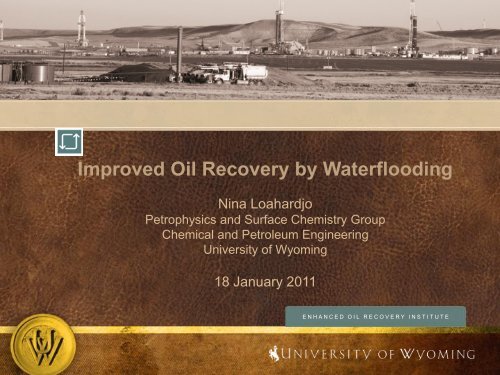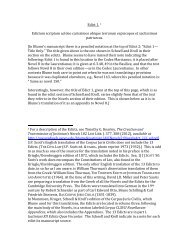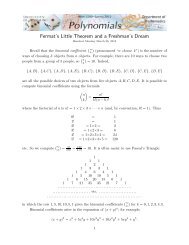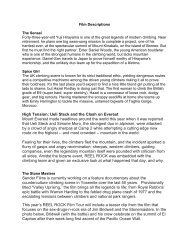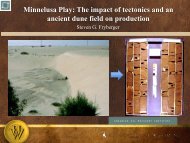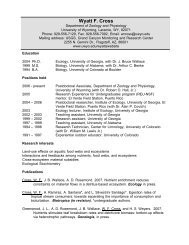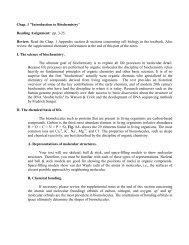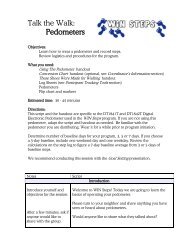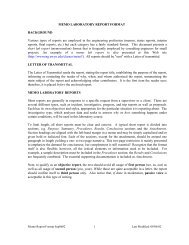Improved Oil Recovery by Waterflooding - University of Wyoming
Improved Oil Recovery by Waterflooding - University of Wyoming
Improved Oil Recovery by Waterflooding - University of Wyoming
Create successful ePaper yourself
Turn your PDF publications into a flip-book with our unique Google optimized e-Paper software.
<strong>Improved</strong> <strong>Oil</strong> <strong>Recovery</strong> <strong>by</strong> <strong>Waterflooding</strong><br />
Nina Loahardjo<br />
Petrophysics and Surface Chemistry Group<br />
Chemical and Petroleum Engineering<br />
<strong>University</strong> <strong>of</strong> <strong>Wyoming</strong><br />
18 January 2011<br />
E N H A N C E D O I L R E C O V E R Y I N S T I T U T E
Project Personal<br />
• Norman Morrow<br />
• Carol Robinson (administration)<br />
• Winoto Winoto, Ph.D.<br />
– Low salinity, removal <strong>of</strong> water blocks, rate effect, and core properties for screening cores<br />
• Nina Loahardjo, Ph.D.<br />
– Low salinity, sequential waterflooding, and interfacial properties<br />
• Siluni Wickramatilaka, Ph.D.<br />
– Spontaneous Imbibition – scaling <strong>of</strong> viscosity ratio etc., gravity dominated imbibition, MRI imaging<br />
<strong>of</strong> an imbibition front, low salinity imbibition at Sor, surfactant enhanced imbibition<br />
• Pu Hui, Ph.D.<br />
– Low salinity flooding <strong>of</strong> reservoir cores including CBM water, chemical analysis and inline<br />
monitoring <strong>of</strong> pH and conductivity <strong>of</strong> effluent brine<br />
• Behrooz Raeesi, Ph.D. Student<br />
– Drainage/imbibition capillary pressure data, theory and experiments on surface energy, wetting and<br />
surface roughness<br />
EORI staff<br />
• Peugui Yin<br />
– Petrophysics: thin section analysis and data acquisition: surface areas, clay analysis, cation<br />
exchange capacities (Susan Schwapp)<br />
• Shaochang Wo<br />
– Data analysis, modelling, simulation<br />
Machine shop<br />
E N H A N C E D O I L R E C O V E R Y I N S T I T U T E<br />
• Ron Borgialli, George Twitchell, and Dean Twitchell
• Jill Buckley<br />
Adjunct Pr<strong>of</strong>essors<br />
• Crude oil characterization, wetting, low salinity and sequential<br />
waterflooding recovery mechanisms, adhesion, interfacial<br />
tension, asphaltene phase behavior<br />
• Koichi Takamura<br />
• <strong>Recovery</strong> mechanisms, surfactants, emulsions, dispersions,<br />
DLVO theory, fundamentals <strong>of</strong> interfacial tensions including<br />
effect <strong>of</strong> pH and salinity for crude oils<br />
• Ge<strong>of</strong>f Mason<br />
• Spontaneous imbibition, pressures at imbibition front and core<br />
face, viscosity ratios – correlations and theory, bubble snap-<strong>of</strong>f<br />
and capillary back pressure for precise pore geometries, nuclear<br />
tracer imaging and interpretation (with EU N H ABergen) N C E D O I L R E C O V E R Y I N S T I T U T E
•Australian National <strong>University</strong><br />
Collaborations<br />
•Digital Core Consortium for Wettability : Mark Knackstedt, Andrew Fogden, Munish Kumar, Evgenia<br />
Lebedevia and Tim Senden<br />
Micro X-ray CT Imaging and Surface Chemical Techniques Related to <strong>Recovery</strong> Mechanisms for Crude <strong>Oil</strong><br />
and Core (Tensleep and Minnelusa) Which Complement UW Coreflood and Imbibition Studies<br />
•<strong>University</strong> <strong>of</strong> Manitoba: Doug Ruth<br />
Simulation and Theory <strong>of</strong> Imbibition<br />
•<strong>University</strong> <strong>of</strong> Bergen: Arne Graue and Martin Fernø<br />
Nuclear Tracer Imaging <strong>of</strong> Imbibition<br />
•ConocoPhillips: James Howard and Jim Stevens<br />
MRI Imaging <strong>of</strong> Sequential flooding, Spontaneous Imbibition, and Low Salinity Flooding<br />
•<strong>University</strong> <strong>of</strong> Kyoto<br />
Application <strong>of</strong> Molecular Simulation to Interpretation <strong>of</strong> the Interfacial and Surface Properties <strong>of</strong> Crude <strong>Oil</strong><br />
•<strong>University</strong> <strong>of</strong> Edmonton: David Potter<br />
Tracking the Movement <strong>of</strong> Clay Particles Within Porous Media from Magnetic Properties<br />
•Chevron: Guoqing Tang<br />
Low Salinity <strong>Waterflooding</strong> – Industrial X-Ray Imaging<br />
E N H A N C E D O I L R E C O V E R Y I N S T I T U T E
July 2010 onward<br />
Presentations<br />
• Morrow, N:” Interfacial Properties and <strong>Improved</strong> <strong>Oil</strong> <strong>Recovery</strong> <strong>by</strong> <strong>Waterflooding</strong>”, presented at Technical Advisory Board for<br />
Enhanced <strong>Oil</strong> <strong>Recovery</strong> Institute, <strong>University</strong> <strong>of</strong> <strong>Wyoming</strong>, July 2010<br />
• Loahardjo, N., Xie, X., Winoto, W., Buckley, J., and Morrow, N.R., “<strong>Improved</strong> <strong>Oil</strong> <strong>Recovery</strong> <strong>by</strong> Sequential <strong>Waterflooding</strong>”,<br />
presented at the 14th Annual Gulf <strong>of</strong> Mexico Deepwater Technical Symposium, New Orleans, LA, Aug. 19-19, 2010.<br />
• Xie, X., Pu, H., Buckley, J., Morrow, N.R., and Carlisle, C., “Low Salinity <strong>Waterflooding</strong> and <strong>Improved</strong> <strong>Oil</strong> <strong>Recovery</strong>”, presented<br />
at the 14th Annual Gulf <strong>of</strong> Mexico Deepwater Technical Symposium, New Orleans, LA, Aug. 19-19, 2010.<br />
• Morrow, N. and Mason, G:”Areas <strong>of</strong> Crude <strong>Oil</strong>/Rock Contact That Govern The Development <strong>of</strong> Mixed Wet Rocks”, presented at<br />
11th International Symposium on Reservoir Wettability Calgary, AB, Canada, September 2010<br />
• Loahardjo, N., Xie, X., Winoto, W., Buckley, J. and Morrow, N.:”Mechanism <strong>of</strong> <strong>Improved</strong> <strong>Oil</strong> <strong>Recovery</strong> <strong>by</strong> Sequential<br />
<strong>Waterflooding</strong>”, ”, presented at 11th International Symposium on Reservoir Wettability Calgary, AB, Canada, September 2010<br />
• Buckley, J. and Morrow, N.:”<strong>Improved</strong> <strong>Oil</strong> <strong>Recovery</strong> <strong>by</strong> Low Salinity <strong>Waterflooding</strong>: A Mechanistic Review”, presented at 11th International Symposium on Reservoir Wettability Calgary, AB, Canada, September 2010<br />
• Morrow, N. and Mason, G:”Spontaneous Imbibition Into Cores with Different Boundary Conditions”, presented at 11th International Symposium on Reservoir Wettability Calgary, AB, Canada, September 2010<br />
• Wickramatilaka, S., Mason, G., Morrow, N., Howard, J. and Stevens.:” Magnetic Resonance Imaging <strong>of</strong> <strong>Oil</strong> <strong>Recovery</strong> during<br />
Spontaneous Imbibitions”, presented at 11th International Symposium on Reservoir Wettability Calgary, AB, Canada, September<br />
2010<br />
• Loahardjo, N.: “Mechanism <strong>of</strong> <strong>Improved</strong> <strong>Oil</strong> <strong>Recovery</strong> <strong>by</strong> Sequential <strong>Waterflooding</strong>” Chemical & Petroleum Engineering Graduate<br />
seminar, Nov. 8, 2010.<br />
• Takamura, K., Loahardjo, N., Buckley, J., Morrow, N, Kunieda, M., Liang, Y. and Matsuoka, T.:” Preferential Accumulation <strong>of</strong><br />
Light End Alkanes and Aromatics at The Crude <strong>Oil</strong>/Air and Crude <strong>Oil</strong>/Water Interfaces: Potential Mechanism <strong>of</strong> Accelerated Tar<br />
Ball Formation from Spilled Crude <strong>Oil</strong>”, be presented at the Annual SME Meeting, Denver, February 27 – March 2, 2011<br />
E N H A N C E D O I L R E C O V E R Y I N S T I T U T E
July 2010 onward<br />
Publications<br />
• Mason, G., Fisher, H., Morrow, N.R., and Ruth, D.W.: “Correlation for the Effect <strong>of</strong> Fluid Viscosities on Counter-Current<br />
Spontaneous Imbibition”, JPSE. 72, (August) 2010, 195-205.<br />
• Loahardjo, N., Xie, X., and Morrow, N.R., “<strong>Oil</strong> <strong>Recovery</strong> <strong>by</strong> Sequential <strong>Waterflooding</strong> <strong>of</strong> Mixed-Wet Sandstone and Limestone”,<br />
Energy Fuels 24 (9) 5073-5080, Web published August 30, 2010.<br />
• Pu, H., Xie, X., Yin, P. and Morrow, N.:”Low Salinity <strong>Waterflooding</strong> and Mineral Dissolution”, SPE 134042, SPE Annual Meeting<br />
Technical Conference and Exhibition, Florence, Italy, September 2010<br />
• Pu, H., “<strong>Recovery</strong> <strong>of</strong> Crude <strong>Oil</strong> from Outcrop and Reservoir Sandstone <strong>by</strong> Low Salinity <strong>Waterflooding</strong>”, PhD Defense, Sept. 27,<br />
2010<br />
• Wickramatilaka, S., G., Morrow, N. and Howard, J.:”Effect <strong>of</strong> Salinity on <strong>Oil</strong> <strong>Recovery</strong> <strong>by</strong> Spontaneous Imbibition”, 24<br />
E N H A N C E D O I L R E C O V E R Y I N S T I T U T E<br />
th<br />
International Symposium on the Core Analysts, Halifax, Nova Scotia, Canada, October 2010<br />
• Kumar, K., Fodgen, A., Morrow N. and Buckley J.:”Mechanisms <strong>of</strong> <strong>Improved</strong> oil <strong>Recovery</strong> from sandstone <strong>by</strong> Low Salinity<br />
Flooding”, 24th International Symposium on the Core Analysts, Halifax, Nova Scotia, Canada, October 2010<br />
• Loahardjo, N., Morrow, N., Stevens, J. and Howard, J.:”Nuclear Magnetic Resonance Imaging: Application to Determination <strong>of</strong><br />
Saturation Changes in a Sandstone Core <strong>by</strong> Sequential <strong>Waterflooding</strong>”, 24th International Symposium on the Core Analysts,<br />
Halifax, Nova Scotia, Canada, October 2010<br />
• Morrow, N., and Buckley, J. ” <strong>Improved</strong> <strong>Oil</strong> <strong>Recovery</strong> <strong>by</strong> Low Salinity <strong>Waterflooding</strong>”, SPE Distinguished Author Series, October<br />
2010<br />
• Morrow, N.:” Low salinity <strong>Waterflooding</strong>”, EORI Newsletter, <strong>Wyoming</strong>, October 2010<br />
• Fogden, A., Kumar, M., Morrow, N.R., Buckley, J.S.: “Mobilization <strong>of</strong> Fine Particles during Flooding <strong>of</strong> Sandstones, and Possible<br />
Relations to Enhanced <strong>Oil</strong> <strong>Recovery</strong>”, Energy Fuels, submitted November, 2010.<br />
• Li, Y., Mason, G., Morrow, N. and Ruth D.:” Capillary Pressure at A Saturation Front during Restricted Counter-Current<br />
Spontaneous Imbibition with Liquid Displacing Air”, Transport in Porous Media, November, 2010<br />
• Siluni Wickramathilaka, “<strong>Oil</strong> <strong>Recovery</strong> <strong>by</strong> Spontaneous Imbibition,” Dec. 1, 2010, PhD. Defense<br />
15 Manuscripts in Preparation for 2011
TOPICS<br />
• Screening outcrop cores for model rocks for low<br />
salinity waterflooding<br />
• Low salinity waterflooding with mineral dissolution<br />
– Eolian sandstones containing dolomite and anhydrites<br />
but without clays (Tensleep, Minnelusa, and Phosphoria)<br />
• Sequential waterflooding<br />
– Mechanisms <strong>of</strong> Sequential waterflooding<br />
– Field test applications<br />
E N H A N C E D O I L R E C O V E R Y I N S T I T U T E
<strong>Oil</strong> <strong>Recovery</strong>: <strong>Waterflooding</strong><br />
Single 5-Spot Well Pattern<br />
E N H A N C E D O I L R E C O V E R Y I N S T I T U T E
Laboratory Measurement <strong>of</strong><br />
<strong>Oil</strong> <strong>Recovery</strong> <strong>by</strong> <strong>Waterflooding</strong><br />
brine<br />
core<br />
<strong>Oil</strong> <strong>Recovery</strong>, %OOIP<br />
100<br />
80<br />
60<br />
40<br />
20<br />
0<br />
Target for Tertiary <strong>Recovery</strong><br />
<strong>Oil</strong> <strong>Recovery</strong> <strong>by</strong> Waterflood<br />
0 2 4 6 8 10 12<br />
Brine Injected, PV<br />
E N H A N C E D O I L R E C O V E R Y I N S T I T U T E
Definitions<br />
• Low Salinity <strong>Waterflooding</strong> (LSW) at S or<br />
– Low salinity waterflooding <strong>of</strong> watered-out reservoir, nominally at<br />
residual oil saturation, S or, after High Salinity <strong>Waterflooding</strong> (HSW)<br />
(common approach)<br />
R wf (%OOIP)<br />
100<br />
80<br />
60<br />
40<br />
20<br />
0<br />
Core U : R1/C1<br />
LC Crude <strong>Oil</strong><br />
HSW<br />
LSW<br />
LSE<br />
0 2 4 6 8 10 12<br />
Brine Injected, PV<br />
Loahardjo et al., 2007<br />
E N H A N C E D O I L R E C O V E R Y I N S T I T U T E
Definitions (cont’d)<br />
• Low Salinity <strong>Waterflooding</strong> (LSW) at S wi<br />
– secondary mode low salinity waterflooding that begins at initial water<br />
saturation, S wi (growing interest)<br />
Loahardjo et al., 2010<br />
E N H A N C E D O I L R E C O V E R Y I N S T I T U T E
# # # <strong>of</strong> <strong>of</strong> <strong>of</strong> No. No. No. Papers Papers Papers <strong>of</strong> <strong>of</strong> <strong>of</strong> Published Published Published & & & Presentations<br />
Presentations<br />
Presentations Papers Papers Papers<br />
Low Salinity <strong>Waterflooding</strong><br />
25<br />
20<br />
15<br />
10<br />
5<br />
0<br />
1996 1996 1996<br />
UW<br />
Other<br />
1998 1998 1998<br />
1999 1999 1999<br />
2000 2000 2000<br />
2001 2001 2001<br />
2002 2002 2002<br />
2003 2003 2003<br />
2004 2004 2004<br />
Year<br />
Figure 3. Histogram <strong>of</strong> Low Salinity Papers and Presentations<br />
EORI Newsletter Fall 2010<br />
Mechanism <strong>of</strong> Low Salinity <strong>Waterflooding</strong> ?<br />
SPE Distinguished Author article on LSE (Morrow and Buckley, 2010)<br />
2005 2005 2005<br />
2006 2006 2006<br />
2007 2007 2007<br />
2008 2008 2008<br />
2009 2009 2009<br />
2010 2010 2010<br />
E N H A N C E D O I L R E C O V E R Y I N S T I T U T E
Main Hindrances to Systematic<br />
Investigation <strong>of</strong> Low Salinity Flooding<br />
• The type <strong>of</strong> Berea sandstone which<br />
responded to low salinity waterflooding is<br />
no longer available<br />
• Currently available Berea shows little<br />
(< 2% OOIP increase) if there is any<br />
response to low salinity flooding<br />
E N H A N C E D O I L R E C O V E R Y I N S T I T U T E
Solutions/work in progress<br />
A. Work with reservoir crude oil/brine/rock<br />
Reservoir cores are generally more responsive than outcrop<br />
cores but :<br />
• coring are expensive<br />
• duplicate core plugs are not usually available because <strong>of</strong> heterogeneity<br />
• core quality, history, cleaning and re-use <strong>of</strong> cores are problematic.<br />
• quality <strong>of</strong> crude oil samples can be uncertain<br />
Papers on reservoir sandstone and carbonate results are in<br />
preparation, covering:<br />
• Step changes in salinity<br />
• Injection flow rate<br />
• Intermissions in flow<br />
• Effluent brine analysis<br />
• Etc.<br />
E N H A N C E D O I L R E C O V E R Y I N S T I T U T E
Solutions/work in progress<br />
B. Total has identified a responsive outcrop<br />
Three groups have reported response (U. <strong>of</strong> <strong>Wyoming</strong>, U.<br />
Bordeaux, and U. <strong>of</strong> Stavanger)<br />
• Cost, heterogeneity, and logistics <strong>of</strong> supply are still a problem<br />
E N H A N C E D O I L R E C O V E R Y I N S T I T U T E
Solutions/work in progress<br />
C. Screening Outcrop Cores<br />
for Model Rocks for Low<br />
Salinity <strong>Waterflooding</strong><br />
E N H A N C E D O I L R E C O V E R Y I N S T I T U T E
Screening <strong>of</strong> commercially available outcrop<br />
Klinkenberg Permeability, mD<br />
Klinkenberg Permeability, mD<br />
10000<br />
1000<br />
100<br />
10<br />
1<br />
0.1<br />
Berea Buff<br />
Berea Stripe<br />
Idaho Hard<br />
Wisconsin<br />
Silurian Dolomite<br />
Bentheimer<br />
Parker<br />
Torrey Buff<br />
Briar Hill<br />
Boise<br />
Leopard<br />
Castle Gate<br />
Sister Gray<br />
Berea<br />
Kir<strong>by</strong><br />
Edwards<br />
0 5 10 15 20 E N25 25 H A N C E D 30 O I L R E C O35 35 V E R Y I N40 40 S T I T U T E 45<br />
Porosity, %<br />
Bandera Gray<br />
Bandera Brown<br />
Austin Chalk<br />
Idaho Gray<br />
Cordova Cream<br />
Stephen Xtra<br />
Georgetown<br />
Edwards Brown
Berea Stripe,<br />
K klink=382–457 mD, f=20.1–20.5%<br />
Briar Hill,<br />
K klink=5,500–5,900 mD, f=23.7–24.2%<br />
Castle Gate,<br />
K klink=1,140–1,300 mD, f=25.0–25.6%<br />
Idaho Gray,<br />
Kklink=5,600–7,200 mD, f=28.6–29.7%<br />
E N H A N C E D O I L R E C O V E R Y I N S T I T U T E
R wf (% OOIP)<br />
100<br />
80<br />
60<br />
40<br />
20<br />
Berea Stripe (WP Crude <strong>Oil</strong>)<br />
T a = 60 o C ; T d = 60 o C<br />
k g = 463 mD ; k b = 282 mD<br />
S wi = 23%<br />
Seawater<br />
20x Dilution <strong>of</strong> Seawater<br />
2.3% OOIP<br />
0<br />
0 5 10 15 20 25 30 35 40 0<br />
Injected Brine, PV<br />
pH<br />
P (psi)<br />
Low Salinity <strong>Waterflooding</strong> for Berea Stripe Outcrop<br />
14<br />
12<br />
10<br />
8<br />
6<br />
4<br />
2<br />
E N H A N C E D O I L R E C O V E R Y I N S T I T U T E<br />
pH and P (psi)
R wf (% OOIP)<br />
100<br />
80<br />
60<br />
40<br />
20<br />
Idaho Gray (WP Crude <strong>Oil</strong>)<br />
T a = 60 o C ; T d = 60 o C<br />
k g = 7.2 D ; k b = 700 mD<br />
S wi = 22%<br />
Seawater<br />
3.3% OOIP<br />
P (psi)<br />
0<br />
0 5 10 15 20 25 30 0<br />
Injected Brine, PV<br />
Low Salinity <strong>Waterflooding</strong> for Idaho Gray Outcrop<br />
p<br />
20x Dilution <strong>of</strong> Seawater<br />
16<br />
14<br />
12<br />
10<br />
8<br />
6<br />
4<br />
2<br />
E N H A N C E D O I L R E C O V E R Y I N S T I T U T E<br />
pH and P (psi)
R wf (% OOIP)<br />
100<br />
80<br />
60<br />
40<br />
20<br />
Briar Hill (WP Crude <strong>Oil</strong>)<br />
T a = 60 o C ; T d = 60 o C<br />
k g = 5.6 D ; k b = 700 mD<br />
S wi = 27%<br />
Seawater<br />
20x Dilution <strong>of</strong> Seawater<br />
3.7% OOIP<br />
0<br />
0 5 10 15 20 25 30 0<br />
Injected Brine, PV<br />
Low Salinity <strong>Waterflooding</strong> for Briar Hill Outcrop<br />
pH<br />
P (psi)<br />
14<br />
12<br />
10<br />
8<br />
6<br />
4<br />
2<br />
E N H A N C E D O I L R E C O V E R Y I N S T I T U T E<br />
pH and P (psi)
R wf (% OOIP)<br />
100<br />
80<br />
60<br />
40<br />
20<br />
Castle Gate (WP Crude <strong>Oil</strong>)<br />
T a = 60 o C ; T d = 60 o C<br />
k g = 1.3 D ; k b = 460 mD<br />
S wi = 24%<br />
Seawater<br />
20x Dilution <strong>of</strong> Seawater<br />
(psi)<br />
10<br />
P<br />
8<br />
and<br />
pH<br />
pH<br />
6<br />
P (psi)<br />
4.6% OOIP<br />
0<br />
0 5 10 15 20 25 0<br />
Injected Brine, PV<br />
Low Salinity <strong>Waterflooding</strong> for Castle Gate Outcrop<br />
14<br />
12<br />
4<br />
2<br />
E N H A N C E D O I L R E C O V E R Y I N S T I T U T E
enefit compare to<br />
waterflood results (%)<br />
40<br />
35<br />
30<br />
25<br />
20<br />
15<br />
10<br />
5<br />
0<br />
1<br />
2<br />
Low salinity Effect<br />
3<br />
4<br />
Reservoir cores<br />
(Lager et al., 2006)<br />
SorHSWSorLSW <br />
SoiSorLSW <br />
5<br />
6<br />
8<br />
Endicott core<br />
% benefit 100%<br />
9<br />
10<br />
11<br />
12<br />
13<br />
Endicott field average<br />
(Seccombe et al., 2008)<br />
14<br />
15<br />
16<br />
17<br />
18<br />
E N H A N C E D O I L R E C O V E R Y I N S T I T U T E<br />
40<br />
35<br />
30<br />
25<br />
20<br />
15<br />
10<br />
5<br />
0<br />
Outcrop<br />
cores<br />
Berea<br />
Stripe<br />
Idaho<br />
Gray<br />
Briar<br />
Hill<br />
Castle<br />
gate
LSW from LC Reservoir Core<br />
R wf (%OOIP)<br />
100<br />
80<br />
60<br />
40<br />
20<br />
0<br />
Core U : R1/C1<br />
LC Crude <strong>Oil</strong><br />
HSW<br />
LSW<br />
14% OOIP<br />
P<br />
pH<br />
0<br />
0 2 4 6 8<br />
Brine Injected, PV<br />
10 12<br />
40<br />
30<br />
20<br />
10<br />
Pressure Drop (psi) and pH<br />
Loahardjo et al., 2007<br />
The result shows benefit to LSW compared to HSW is 43%<br />
E N H A N C E D O I L R E C O V E R Y I N S T I T U T E
Importance <strong>of</strong> Laboratory Coreflood<br />
Tests on Reservoir for LSW<br />
• For any positive LSW effect, tests on reservoir core show<br />
substantial response (averaged at 14%) as opposed to low<br />
response (0-9.6%) on tested outcrop core to date<br />
• Single well chemical tracer tests showed 13% OOIP reduction<br />
in residual oil, consistent with laboratory core test (McGuire et<br />
al. 2005)<br />
• A candidate North Sea field that met the necessary condition<br />
for low salinity effect did not respond to LSW in either<br />
laboratory or pilot test (Skrettingland et al. 2010)<br />
• The correlation between laboratory coreflood test and field<br />
test results confirms the need for individual laboratory tests for<br />
screening low salinity candidate;<br />
The variability in response demonstrates the value<br />
<strong>of</strong> laboratory tests in screening candidate reservoirs<br />
E N H A N C E D O I L R E C O V E R Y I N S T I T U T E
2. Low Salinity <strong>Waterflooding</strong><br />
with Mineral Dissolution<br />
Studies on <strong>Wyoming</strong> Reservoirs using<br />
Low Salinity - Coal Bed Methane Water<br />
E N H A N C E D O I L R E C O V E R Y I N S T I T U T E
Target Formations<br />
• Minnelusa (Gibbs) and Tensleep (Teapot Dome) eolian<br />
sandstones<br />
One half <strong>of</strong> <strong>Wyoming</strong>’s oil production<br />
Abundant dolomite & anhydrite cement<br />
Formation water salinity: 3,300 – 38,650 ppm<br />
Low salinity water: Coalbed Methane Water (1,316 ppm)<br />
• Phosphoria (Cottonwood) dolomite formation<br />
<strong>Recovery</strong> factor as low as 10%<br />
Patchy anhydrite<br />
Formation water salinity: 30,755 ppm<br />
Low salinity water: Diluted formation water (1,537 ppm)<br />
E N H A N C E D O I L R E C O V E R Y I N S T I T U T E
<strong>Oil</strong> sample<br />
Crude <strong>Oil</strong>s<br />
n-C 6 Asph<br />
[%wt]<br />
Acid #<br />
[mg KOH/g oil]<br />
Base #<br />
[mg KOH/g oil]<br />
Tensleep 3.2 0.16 0.96<br />
Minnelusa 9.0 0.17 2.29<br />
Phosphoria 2.9 0.56 1.83<br />
E N H A N C E D O I L R E C O V E R Y I N S T I T U T E
100 mm<br />
Minnelusa Rock from <strong>Oil</strong> Zone<br />
Dolomite<br />
Anhydrite<br />
• Mineralogy: sandstone with abundance dolomite and anhydrites cements<br />
• Porosity: 12.2 -18.1%<br />
• Permeability: 63.7 – 174.2 mD<br />
E N H A N C E D O I L R E C O V E R Y I N S T I T U T E<br />
Dolomite<br />
Pu et al., 2010
<strong>Oil</strong> recovery, %OOIP<br />
100<br />
90<br />
80<br />
70<br />
60<br />
50<br />
40<br />
30<br />
20<br />
10<br />
0<br />
M1<br />
K g = 78.4 md, f = 14.6%<br />
S wi = 8.2%,<br />
MW (38,651ppm)<br />
0 2 4 6 8 10 12 14 16 18<br />
Brine injected, PV<br />
+5.8%<br />
CBMW (1,316ppm)<br />
Low Salinity <strong>Waterflooding</strong> for Minnelusa Rock from <strong>Oil</strong> Zone<br />
25<br />
20<br />
15<br />
10<br />
E N H A N C E D O I L R E C O V E R Y I N S T I T U T E<br />
5<br />
0<br />
Pu et al., 2010<br />
Pressure drop, psi
Phosphoria Rock from Cottonwood Creek Field<br />
100 mm<br />
Vug<br />
Dolomite<br />
Mineralogy: Crystallin dolomite and patchy anhydrites<br />
Porosity: 9.5 -19.6%<br />
Permeability: 0.25 – 294 md<br />
Dolomite<br />
Pu et al., 2010<br />
E N H A N C E D O I L R E C O V E R Y I N S T I T U T E
<strong>Oil</strong> recovery, %OOIP<br />
100<br />
90<br />
80<br />
70<br />
60<br />
50<br />
40<br />
30<br />
20<br />
10<br />
0<br />
P1<br />
K g = 6.8 md, f = 9.5%<br />
S wi = 22.7%<br />
PW<br />
30,755ppm<br />
K we1 = 2.1 md<br />
+8.1%<br />
0 5 10 15 20 25 30 35 40 45 50<br />
Brine injected, PV<br />
5% PW dilute<br />
1,537ppm<br />
K we2 = 1.1 md<br />
Low Salinity <strong>Waterflooding</strong> for Phosphoria Rock<br />
30<br />
25<br />
20<br />
15<br />
10<br />
E N H A N C E D O I L R E C O V E R Y I N S T I T U T E<br />
5<br />
0<br />
Pu et al., 2010<br />
Pressure drop, psi
100 mm<br />
Tensleep Rock from <strong>Oil</strong> Zone<br />
Dolomite<br />
quartz<br />
dolomite<br />
anhydrite<br />
• Mineralogy: sandstone with dolomite and anhydrites cements<br />
• Porosity: 8.6 -15.7%<br />
• Permeability: 7.0 – 42.7 md<br />
Pu et al., 2010<br />
E N H A N C E D O I L R E C O V E R Y I N S T I T U T E
<strong>Oil</strong> recovery, %OOIP<br />
100<br />
90<br />
80<br />
70<br />
60<br />
50<br />
40<br />
30<br />
20<br />
10<br />
0<br />
T4<br />
K g = 22.9 md, f = 12.5%<br />
S wi = 15.3%<br />
MW<br />
38,651ppm<br />
K we1 = 0.53 md<br />
CBMW<br />
1,316ppm<br />
0 10 20 30 40 50 60 70<br />
Brine injected, PV<br />
+5.2%<br />
K we2 = 0.55 md<br />
Low Salinity <strong>Waterflooding</strong> for Tensleep Rock from <strong>Oil</strong> Zone<br />
90<br />
80<br />
70<br />
60<br />
50<br />
40<br />
30<br />
20<br />
10<br />
E N H A N C E D O I L R E C O V E R Y I N S T I T U T E<br />
0<br />
Pu et al., 2010<br />
Pressure drop, psi
Anhydrates dissolution in Tensleep rock – the green regions show the region<br />
<strong>of</strong> cement dissolutions after flooding with CBM water (Lebedeva et al., 2009)<br />
E N H A N C E D O I L R E C O V E R Y I N S T I T U T E
100 mm<br />
Tensleep Rock from Aquifer<br />
Dolomite<br />
Dolomite<br />
Mineralogy: sandstone with interstitial dolomite crystals and minimal anhydrates<br />
Porosity: 17 -18.7%<br />
Permeability: 50.8 – 228.5 md<br />
Pu et al., 2010<br />
E N H A N C E D O I L R E C O V E R Y I N S T I T U T E
<strong>Oil</strong> recovery, %OOIP<br />
100<br />
90<br />
80<br />
70<br />
60<br />
50<br />
40<br />
30<br />
20<br />
10<br />
0<br />
Core# K g (md) f S wi (%)<br />
TA1 228.5 18.7 22.4<br />
TA2 50.8 18.1 20.4<br />
MW<br />
38,651ppm<br />
CBMW<br />
1,316ppm<br />
0 5 10 15 20 25 30<br />
Brine injected, PV<br />
R TA1<br />
K we = 10.4 md<br />
P TA1<br />
K we = 1.1md<br />
P TA2<br />
R TA2<br />
Low Salinity <strong>Waterflooding</strong> for Tensleep Rock from Aquifer<br />
30<br />
25<br />
20<br />
15<br />
10<br />
E N H A N C E D O I L R E C O V E R Y I N S T I T U T E<br />
5<br />
0<br />
Pu et al., 2010<br />
Pressure drop, psi
Silurian Dolomite Outcrop<br />
Mineralogy: interstitial dolomite and no anhydrates<br />
Porosity: 17 – 20%<br />
Permeability: 100 mD – 1,000 md<br />
E N H A N C E D O I L R E C O V E R Y I N S T I T U T E
R wf (% OOIP)<br />
100<br />
80<br />
60<br />
40<br />
20<br />
Silurian Dolomite (WP Crude <strong>Oil</strong>)<br />
T a = 60 o C ; T d = 60 o C<br />
k g = 102 mD ; k b = 19 mD<br />
S wi = 24%<br />
Seawater<br />
P (psi)<br />
20x Dilution<br />
<strong>of</strong> Seawater<br />
0<br />
0 5 10 15 20 25 30 35 0<br />
Injected Brine, PV<br />
Low Salinity <strong>Waterflooding</strong> for Silurian Dolomite Outcrop<br />
pH<br />
35<br />
30<br />
25<br />
20<br />
15<br />
10<br />
E N H A N C E D O I L R E C O V E R Y I N S T I T U T E<br />
5<br />
pH and P (psi)
Summary<br />
• Tensleep and Minnelusa sandstones, and<br />
Phosphoria dolomite all contained<br />
anhydrites and all responded to low<br />
salinity waterflooding<br />
• Tensleep sandstone from an aquifer and<br />
Silurian dolomite outcrop did not contain<br />
any noticeable anhydrites and did not<br />
respond to low salinity waterflooding<br />
E N H A N C E D O I L R E C O V E R Y I N S T I T U T E
3. Sequential <strong>Waterflooding</strong><br />
Morrow, Xie, and Loahardjo,<br />
US Patent No. WO 2009/12663 A2, October 2009<br />
Morrow, Xie, and Loahardjo,<br />
Pending Provisional Patent No. 61/226,709, July 2009<br />
E N H A N C E D O I L R E C O V E R Y I N S T I T U T E
Effect aging at S or and/or S wi<br />
on sequential waterflooding<br />
E N H A N C E D O I L R E C O V E R Y I N S T I T U T E
<strong>Recovery</strong> <strong>of</strong> Crude <strong>Oil</strong><br />
Medium Permeability Berea Sandstone<br />
Aging at S or after 3 cycles<br />
T a = 75 o C<br />
T d = 60 o C<br />
E N H A N C E D O I L R E C O V E R Y I N S T I T U T E
RR RR (%OOIP) (%OOIP) (%OOIP) (%OOIP)<br />
wf wf wf wf<br />
100<br />
80<br />
60<br />
40<br />
20<br />
PH 2L H 02 (WP Crude <strong>Oil</strong>)<br />
T = 75 a o T = 75 C ; t = 6 months<br />
a a o T = 75 C ; t = 6 months<br />
a a o T = 75 C ; t = 6 months<br />
a a o C ; t = 6 months<br />
a<br />
T = 60 d o T = 60 C (m = 28.8 cP)<br />
d o T = 60 C (m = 28.8 cP)<br />
d o T = 60 C (m = 28.8 cP)<br />
d o C (m = 28.8 cP)<br />
R1/C1 : S = 26% : S = 44%<br />
wi or<br />
R1/C2 : S = 36% : S = 28%<br />
wi or<br />
R1/C3 : S = 46% : S = 19%<br />
wi or<br />
k = 604 mD<br />
g<br />
20 days at S or<br />
R1/C4 : S = 42% : S = 15%<br />
wi or<br />
0<br />
0 1 2 3 4 5 6 7<br />
PV Brine Injected<br />
Sequential waterflooding with wettability control<br />
for medium permeability Berea sandstone<br />
E N H A N C E D O I L R E C O V E R Y I N S T I T U T E
<strong>Recovery</strong> <strong>of</strong> Crude <strong>Oil</strong><br />
Low Permeability Berea Sandstone<br />
Aging at S wi after 4 cycles<br />
followed <strong>by</strong> aging at S or<br />
T a = 75 o C<br />
T d = 60 o C<br />
E N H A N C E D O I L R E C O V E R Y I N S T I T U T E
RR RR RR (%OOIP) (%OOIP) (%OOIP) (%OOIP) (%OOIP) (%OOIP)<br />
wf wf wf wf wf wf<br />
100<br />
80<br />
60<br />
40<br />
20<br />
Ev 2L 2L 02 02 (WP (WP Crude Crude <strong>Oil</strong>)<br />
<strong>Oil</strong>)<br />
T = 75 a o T = 75 C ; t = 6 months<br />
a a o T = 75 C ; t = 6 months<br />
a a o T = 75 C ; t = 6 months<br />
a a o T = 75 C ; t = 6 months<br />
a a o T = 75 C ; t = 6 months<br />
a a o C ; t = 6 months<br />
a<br />
T = 60 d o T = 60 C (m = 28.8 cP)<br />
d o T = 60 C (m = 28.8 cP)<br />
d o T = 60 C (m = 28.8 cP)<br />
d o T = 60 C (m = 28.8 cP)<br />
d o T = 60 C (m = 28.8 cP)<br />
d o C (m = 28.8 cP)<br />
k = = 84 84 mD<br />
mD<br />
g<br />
30 days at S wi<br />
20 days at S or<br />
R1/C1 R1/C1 : : S S = 28% : S = 49%<br />
wi or<br />
R1/C2 : S = 28% : S = 43%<br />
wi wi wi wi wi or<br />
R1/C3 : S = 31% : S = 38%<br />
wi wi wi wi or<br />
R1/C4 : S = 38% : S = 29%<br />
wi or<br />
R1/C5 : S = 34% : S = 38%<br />
wi or<br />
R1/C6 : S wi = 37% : S or = 22%<br />
0<br />
0 1 2 3 4 5 6 7<br />
PV Brine Brine Injected<br />
Injected<br />
Sequential waterflooding with wettability control<br />
for low permeability Berea sandstone<br />
E N H A N C E D O I L R E C O V E R Y I N S T I T U T E
<strong>Recovery</strong> <strong>of</strong> Crude <strong>Oil</strong><br />
High Permeability Berea Sandstone – BS 4<br />
Aging at S or after 4 cycles<br />
followed <strong>by</strong> aging at S wi, S or , S or and S or<br />
Restoration 2<br />
T a = 75 o C; t a = 1 year<br />
T d = 60 o C<br />
E N H A N C E D O I L R E C O V E R Y I N S T I T U T E
21 3 months days at at Sor Sor 25 days at Swi 17 24 days days at at SorSor Sequential waterflooding with wettability control<br />
for high permeability Berea sandstone – Restoration 2<br />
E N H A N C E D O I L R E C O V E R Y I N S T I T U T E
Summary<br />
• Further investigation <strong>of</strong> oil recovery <strong>by</strong> sequential<br />
waterflooding is needed, particularly for different types <strong>of</strong><br />
crude oil, because wettability, and changes in wettability,<br />
depend on specific crude oil/brine/rock interactions<br />
• Aging at high water saturation usually gave increase in<br />
oil recovery, whereas aging at low water saturation<br />
resulted in decreased oil recovery<br />
• Sequential waterflooding without change in salinity and<br />
without cleaning or re-aging between cycles usually<br />
showed sequential reductions in residual oil saturation.<br />
• Single-well field testing <strong>of</strong> sequential waterflooding is<br />
justified<br />
E N H A N C E D O I L R E C O V E R Y I N S T I T U T E
Single-Well Tests <strong>of</strong><br />
Sequential Floods<br />
Calculations are based on a simple<br />
piston-like displacement model<br />
f =20.9%, 30 ft reservoir oil-zone thickness<br />
E N H A N C E D O I L R E C O V E R Y I N S T I T U T E
Reservoir at residual oil saturation after waterflood<br />
(WF1)<br />
Day 0<br />
0 10 20 30 40 50 ft<br />
S OR (WF1)=36.2%<br />
target zone radius = 45 ft<br />
E N H A N C E D O I L R E C O V E R Y I N S T I T U T E
Injection <strong>of</strong> oil into the target zone<br />
Day 1<br />
0 10 20 30 40 50 ft<br />
S OR (WF1)=36.2%<br />
target zone radius = 45 ft<br />
S O=64.9%<br />
oil injected = 100 bbl<br />
E N H A N C E D O I L R E C O V E R Y I N S T I T U T E
Displacement Radial length <strong>of</strong> <strong>of</strong> injected oil reaches oil <strong>by</strong> minimum injection before <strong>of</strong> brine<br />
growing upon more (WF2) injection <strong>of</strong> brine<br />
Day 12<br />
0 10 20 30 40 50 ft<br />
S OR (WF1)=36.2%<br />
inner radial distance<br />
START WATER INJECTION<br />
oil bank radial length<br />
oil bank minimum<br />
radial length= 4.5 ft<br />
oil bank volume = 406 bbl<br />
E N H A N C E D O I L R E C O V E R Y I N S T I T U T E
Continuation <strong>of</strong> oil bank displacement <strong>by</strong><br />
injection <strong>of</strong> brine (WF2)<br />
Day 23<br />
45<br />
6<br />
0 10 20 30 40 50 ft<br />
S OR (WF1)=36.2%<br />
S O=64.9%<br />
S OR (WF2)=28.8%<br />
oil bank radial length= 5.9 ft<br />
oil bank volume = 1,149 bbl<br />
E N H A N C E D O I L R E C O V E R Y I N S T I T U T E
The well is put on production and the oil bank<br />
grows in volume and radial length<br />
Day 68<br />
910<br />
0 10 20 30 40 50 ft<br />
S OR (WF1)=36.2%<br />
E N H A N C E D O I L R E C O V E R Y I N S T I T U T E
The well is put on production and the oil bank<br />
grows in volume and radial length<br />
Day 10 11 12 13 14<br />
0 10 20 30 40 50 ft<br />
S OR (WF1)=36.2%<br />
S OR (WF2)=28.8%<br />
S OR (WF3)=24.0%<br />
E N H A N C E D O I L R E C O V E R Y I N S T I T U T E
100 bbl<br />
oil<br />
100 bbl<br />
oil<br />
Single Well Field Test<br />
2,000 bbl<br />
brine<br />
10,000 bbl<br />
brine<br />
900 bbl oil in 14 days<br />
(as high as 3200 bbl optimistically)<br />
4,000 bbl oil in 62 days<br />
(as high as 15,000 bbl optimistically)<br />
E N H A N C E D O I L R E C O V E R Y I N S T I T U T E
Single Well Field Tests<br />
• Low cost: Injected brine and oil are directly<br />
available: Required oil volume is small<br />
• Test should first be applied to reservoirs<br />
with flow conformance (responded well to<br />
waterflooding), oil viscosity close to that <strong>of</strong><br />
the injected brine and low gas/oil ratio<br />
• Single well tracer tests can be used to<br />
determine residual oil saturations before<br />
and after the process<br />
E N H A N C E D O I L R E C O V E R Y I N S T I T U T E
Field Test ? 2011 ?<br />
Discussion <strong>of</strong> potential field test<br />
with James Seccombe and Scott Digert (BP Alaska)<br />
Laramie, <strong>Wyoming</strong>, October 13, 2010<br />
E N H A N C E D O I L R E C O V E R Y I N S T I T U T E
Further Application <strong>of</strong> Sequential Waterflood<br />
<strong>Improved</strong> <strong>Recovery</strong><br />
<strong>by</strong> Injection <strong>of</strong> Small Volumes <strong>of</strong> <strong>Oil</strong><br />
1. Inject multiple oil banks<br />
(single well or well to well)<br />
2. Reversing production and injection well before breakthrough<br />
to avoid sand production, especially for less consolidated<br />
reservoir<br />
3. Convert a tertiary mode low salinity flood into a more<br />
favorable/effective secondary mode low salinity waterflood<br />
<strong>by</strong> pre-injection <strong>of</strong> oil<br />
4. Establishing initial oil bank for other recovery methods, e.g.<br />
before flooding natural residual oil zone<br />
E N H A N C E D O I L R E C O V E R Y I N S T I T U T E
Ongoing Topics and Future Work<br />
1. Low Salinity <strong>Waterflooding</strong><br />
a. Tests on reservoir rocks<br />
b. Screening outcrop cores, at S wi and S or<br />
c. Attempt to identify a mechanism for LSW<br />
2. Sequential <strong>Waterflooding</strong><br />
a. Further laboratory tests<br />
b. Field tests <strong>of</strong> Sequential <strong>Waterflooding</strong><br />
3. Waterblock Treatment<br />
E N H A N C E D O I L R E C O V E R Y I N S T I T U T E
Acknowledgments<br />
• EORI, <strong>University</strong> <strong>of</strong> <strong>Wyoming</strong><br />
• Wold Chair<br />
• Industry:<br />
Saudi Aramco*, BP*,Chevron, ConocoPhillips, Shell,<br />
StatoilHydro*, Total* (enquiries from Oxy, Kuwait, Maersk)<br />
* includes provision <strong>of</strong> reservoir rock and/or crude oil<br />
Thank You !<br />
E N H A N C E D O I L R E C O V E R Y I N S T I T U T E
<strong>Improved</strong> <strong>Oil</strong> <strong>Recovery</strong> <strong>by</strong> <strong>Waterflooding</strong><br />
Nina Loahardjo<br />
Petrophysics and Surface Chemistry Group<br />
Chemical and Petroleum Engineering<br />
<strong>University</strong> <strong>of</strong> <strong>Wyoming</strong><br />
18 January 2011<br />
E N H A N C E D O I L R E C O V E R Y I N S T I T U T E
E N H A N C E D O I L R E C O V E R Y I N S T I T U T E
E N H A N C E D O I L R E C O V E R Y I N S T I T U T E
E N H A N C E D O I L R E C O V E R Y I N S T I T U T E


